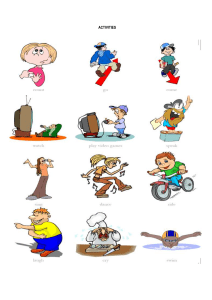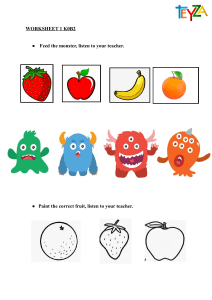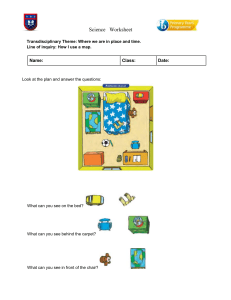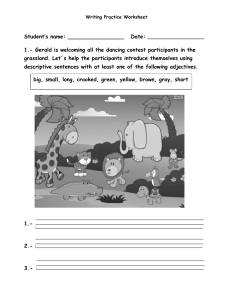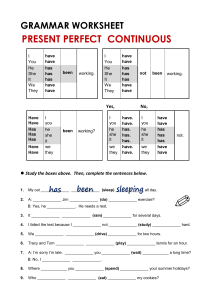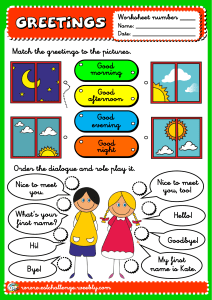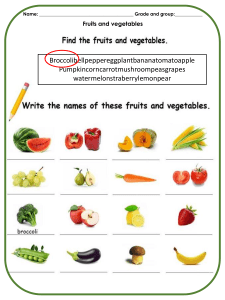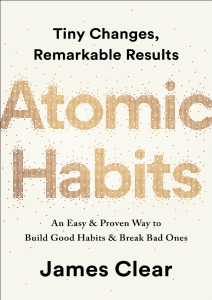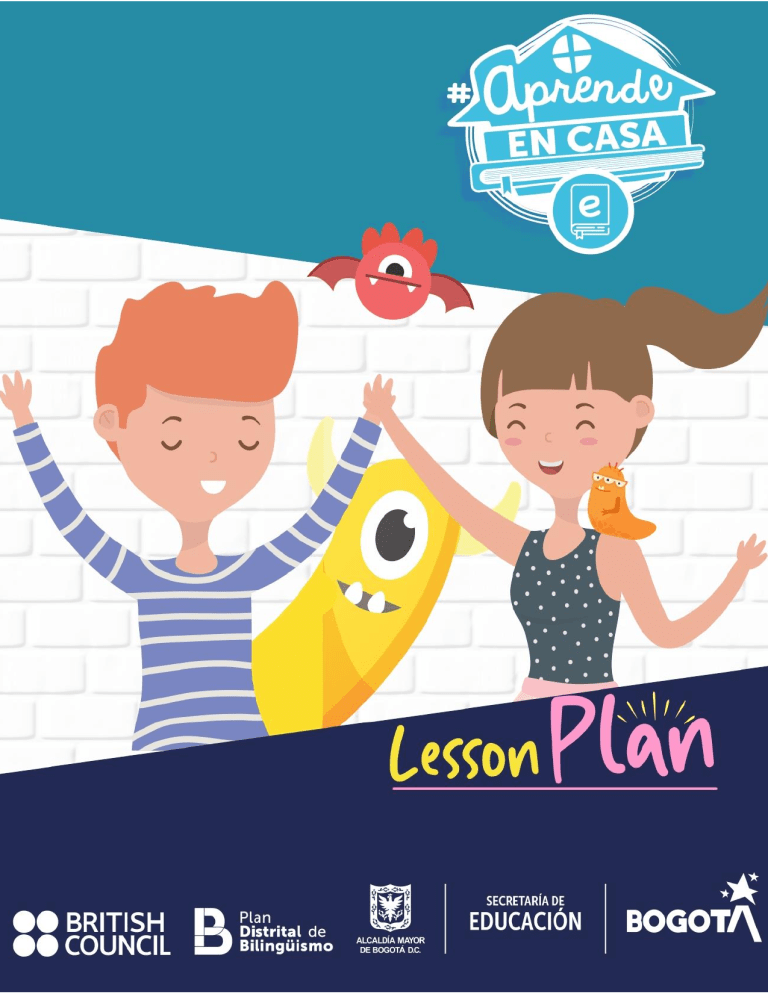
LESSON PLAN 2 Grade: 6th # of students: 45 students Suggested Curriculum Module: 2 Health Language Focus: Length of class: 90 minutes Grammar Reading Vocabulary Listening Skills: Functions Other __________ Speaking Writing Approaches Followed: Average age of students: 9-11 DBA LOTS / HOTS Co-Teaching Project Based Learning Active Learning Problem Based Learning Communicative Approach PPP Task Based Learning Other: Skill-based lesson -Understands and uses familiar words and short phrases about routines, daily activities, and preferences. Remember Understand Apply Analyse Evaluate Create Main aim: By the end of the lesson, students will be able to discuss healthy and unhealthy habits and their effects on wellbeing. Example: I like eating vegetables. She/he loves exercising. Subsidiary aims: ● ● ● ● To consolidate vocabulary regarding personal care and healthy/unhealthy habits To express likes and dislikes (I love eating ..., I like playing …) To ask about likes and dislikes (Do you like …? Does he like …?) To revise present simple Performance indicators: ● ● Knowing ● ● ● ● Doing Identifies essential information related to daily routines and personal care in short written texts with simple language. Recognizes vocabulary related to daily routines and personal care. Identifies the structure of Yes/No questions. Formulates questions related to daily routines and personal care. Answers with short phrases the questions and uses vocabulary and expressions studied. Distinguishes between healthy and unhealthy activities. ● ● ● Being Assumes a responsible position towards personal care. Respects taking turns. Values the contributions of classmates in class. Timetable fit and assumed knowledge For the successful development of this lesson, students are expected to identify words and expressions to talk about routines. Students should also be acquainted with the present simple and adverbs of frequency. The following lesson will focus on identifying environmental issues and different practices to help the environment. Content: Lexical: Lexical set about parts of the body ● Arm ● Legs ● Chest ● Brain ● Grammar ● ● Assumes a responsible position towards personal care. Respects taking turns. Values the contributions of classmates in class. Expressions of time-related to routines ● I eat dinner at 6. ● Before going to bed, I… ● I wake up at … ● Everyday ● First, second, then… ● In the morning… ● In the evening… ● In the afternoon… Discourse ● At night markers/English in Expressions for personal care practice: ● In the morning... I brush my teeth. ● I visit the doctor… ● Take a shower ● Brush teeth ● Comb hair ● Exercise ● Eat healthy ● Drink water ● Sleep well Socio linguistic /Intercultural: ● ● Taking turns Learning through interaction Anticipated problems Planned solutions Schools might not have access to the internet. Teacher (T) prints the worksheets and appendixes provided. Students (Ss) might have difficulties understanding the self-assessment rubric. T explains every single item on it and provides examples. Ss might have difficulties when creating their paragraphs. T monitors students and provides feedback on the sentences created. Ss might have difficulties when understanding some instructions or concepts. T uses a lot of body gestures to make himself/herself understood. Stage Stage aims To get students thinking in English. Warmer (10 min) Procedure T starts the session by asking Ss to watch a video and try to infer what the lesson will be about. https://www.youtube.com/watch?v=_HEnohs6yYw. After watching the video, Ss share ideas with the class about the topic, and then T introduces it. In this first stage of the lesson, T shows some flashcards related to healthy and unhealthy habits (See Appendix 1). T asks Ss if they recognize the activities. T uses the board and divides it into two columns: one has the title “healthy “and the other one “unhealthy”. T draws a happy face next to healthy and a sad face next to unhealthy for Ss to infer the meaning of the two words. To activate Ss T shows the flashcards again and asks Ss to place them in the correct background category. knowledge If this activity is virtual, T shows or projects the flashcards and tells Ss to raise their hand if they consider it is a healthy habit. Time and Interac tion T-SS 3 min T-SS 3 min T-SS 4 MIN T introduces the class vocabulary (See Worksheet 1, Exercise 1). T writes the words on the board or shares his/her screen if it is a virtual class. T numbers the words and tells Ss that they are going to have six seconds to memorize the vocabulary. T can use this timer available on the internet: https://www.online-stopwatch.com/. If this activity is at school, and there is no internet connection, T counts from 1 to 10 simulating a timer. To introduce the vocabulary In small groups, Ss will compete against three classmates to write/say of the class. as many words from the list as possible. Ss will use the chart in Worksheet 2, Exercise 2. Ss tick (√) the box if their partner says/writes the word correctly, otherwise they cross the box if there is a mistake. Ss take turns to say the words. T-SS 5 min T-SS 5MIN Lead-in (20 min) To work on After this activity, T gives Ss Worksheet 2. Ss have the vocabulary list with some missing letters. Ss use their short-term memory to complete memory and spelling the spaces. T then tells the class they will play charades with the vocabulary. T divides the class into two groups. One student (S) from group 1 acts out one word, and the members of his/her group must guess it. Points are allotted to the Ss who guess correctly. T-SS 10MIN Reading Strategies: Previewing and Predicting T shows Ss the title of the reading (“My fit and healthy life”). Based on the title, Ss predict what the reading is going to be about. T writes what Ss say on the board or on an online board or word document that he/she is sharing. T can help Ss by asking questions such as: - What can we do to have a healthy life? Reading To preview predictions the reading (10 min) Now, Ss do Worksheet 3, Exercise 1. They write four healthy habits they have. Ss follow the example given, and they use the class vocabulary. This activity is individual. T-SS 7 MIN When Ss finish writing their sentences, T asks Ss their habits, writes them on the board, and tallies the results to determine the most popular healthy habit. T asks Ss for unhealthy habits, so Ss understand both healthy and unhealthy practices. To prepare Ss to Students read Worksheet 4, Exercise 1. In the text, two people talk identify information about their healthy habits. This exercise is individual. T-SS 3 MIN I-S 5 MIN Reading for gist (20 minutes) To make Ss After Ss read the passages, T asks them to identify and highlight healthy I-S interact habits in the text. There is an example done for them. (Worksheet 4, 5 MIN with the Exercise 2) reading Now, Ss do Worksheet 4, Exercise 3. Ss read the text again and complete the words that are missing. To check Worksheet 4, Exercises 2 and 3, T asks Ss to work in pairs. Ss pretend to be Sebastian and John. They ask each other questions using the answers. T gives Ss an example and then asks Ss to take some time to write three questions. Once they have the questions, Ss start the interaction. T-SS 10 MIN Example: Sebastian, do you eat fruit? Yes, I do. John, do you smoke? No, I don’t. Task: T asks students to create a similar text to the one they read in Worksheet 4, Exercise 1. They are going to talk about their classmate’s habits. First, Ss interview their partners, and then they report their findings. Ss should include the vocabulary and expressions practiced in class. To evaluate the task T can check Rubric in Appendix 2. Step 1: In pairs, Ss work on Worksheet 5, Exercise 1. They make a list of three healthy and three unhealthy habits. creating my To foster Ss’ Step 2: 1) Ss ask their partners questions using the information from paragraph writing skills the chart they created and take notes. (20 min) 2) After they finish interviewing each other, individually, Ss write a short text about their classmates. They use their notes. Ss complete Worksheet 5, Exercise 2. Post task: Language focus A. Analysis - T asks Ss two questions about Sebastian. T writes the answers Ss give. a. Do Sebastian and his dog drink water after exercising? Yes, they do. b. Does he brush his teeth three times a day? Yes, he does. T-SS 20 MIN - T asks Ss how to ask yes/no questions in present simple. T writes the grammar structure on the board and explains its use. B. Practice Ss complete Worksheet 6. Then, they check as a class. In this final stage of the lesson, Ss self-assess their performance during the different stages of the lesson. T gives Ss Worksheet 7. T explains every item of the rubric. Selfevaluation and reflection (10 min) I-S 10 MIN To wrap the class up T reflects upon the importance of having healthy habits related to personal care. Hey students! Having healthy habits is essential for our lives because our body needs to be in good condition to do our daily activities. Materials needed Computers with access to the Internet, paint, Microsoft Word, and PowerPoint. If there are no computers or internet, the teacher will print out the worksheets or use the board. Worksheet 1 Fast Words 1. Look at the new vocabulary for 6 seconds and try to remember as many words as possible. When time is over, try to say/write as many words as possible without looking at the card. 2. Now, compete with your classmates! The first column has the list of words; in the following columns write the name of three classmates you will play with. Each one of you will have six seconds to look at the word and say/write as many as possible. Tick the box if your partner says/writes the word correctly; cross the box if there is a mistake. Take turns to play VOCABULARY DRINK WATER NAME 1: NAME 2: NAME 3: EAT VEGETABLES EXERCISE SLEEP WELL BRUSH MY TEETH SMOKING Worksheet 2 Where are my letters? 1. Complete the spaces with the missing letters. Use your memory to complete the words. Play with your classmates: now that you know these words you can take turns to play charades and guess the word your friends act! Worksheet 3 My fit and healthy life 1. Use the chart to write four of the healthy habits you have. Example: I eat fruit. ______ _______ My fit and healthy life _______ ______ 2. Now, share your sentences with the class to see which is the most popular healthy habit! Worksheet 4 My fit and healthy life Sebastian 1. Now that you know some expressions about healthy habits, let’s read this text about two students like you who will share their habits with us. Hi! I am Sebastian. I love to eat fruits and vegetables. In the mornings, I exercise. I like running with my dog Peter. Peter is strong and fast. I think he is healthier than me. After exercising, we drink water. I love it! I probably drink more than 2 liters per day. I sleep well because I go to bed at 8:30 pm, and I wake up at 6:00 am. Sorry! I forgot to mention something. I brush my teeth three times a day. Hello there! My name is John. I think I am a healthy person because I do not like smoking. My friends from the university smoke a lot, but I try to be far away from them when they do it. I love to eat a lot of fruits especially bananas and watermelons. I exercise a lot because I am part of the university swimming team. Next month, we have a competition, and I need to be the healthiest athlete in the pool. Wish me luck! Bye. John 2. Highlight the sentences that express habits in the reading. Look at the example. 3. Read the following statements and complete the spaces using the information from the previous text. Look at the example. 0. Sebastian enjoys eating fruits. 1. Sebastian drinks a lot of 2. John likes to eat 3. John trains _______________ _____________________ ____________________________ 4. John needs to eat healthy for the _______. . . . 4. Write three questions using the instructions your teacher gives you and the example. Example: Do you eat fruit? Yes, I do. Do you smoke? No, I don’t. a. _______________________________________________________________________________ b. ______________________________________________________________________________ c. ________________________________________________________________________________ Worksheet 5 Your Healthy Habits 1. Make a list of healthy and unhealthy habits; you will write three of each. You can use the class vocabulary, examples from previous exercises, your dictionary, and you can ask your classmates. Healthy Unhealthy 2. Now, ask your partner questions. Take notes and use them to complete the text with your classmate’s information. Hi! My name is _____________________________, and these are (my classmate)’s healthy and unhealthy habits. She/he loves ________________________________________. She/he also likes __________________________________. She/he _________________ _________________________. In contrast, she/he does not drink _______________________________. She/he does not _______________ ________________________________________________. She/he _______ _______________________________________________. In conclusion, I think she/he is a ______________ person. Worksheet 6 1. In this exercise, you will complete the spaces with the appropriate words. I am Martina! I am a professional skater. I like to eat…………………. especially carrots and broccoli. My mom told me they are good for our physical health. I always…………… water before, while, and after training. I need to ……… for more than six hours because my body needs to recover energy. Before going to bed, I ……….. my teeth. 2. Create questions for the following sentences from the text. The first two questions have been done for you. a. I am a professional skater. Is Martina a professional skater? Yes, she is. b. I like to eat vegetables especially carrots and broccoli. Does Martina like to eat vegetables, especially carrots and broccoli? Yes, she does. c. I always…………… water before, while, and after training. ____________________________________________________________________________________ d. I need to ……… for more than six hours because my body needs to recover energy. ____________________________________________________________________________________ e. Before going to bed, I ……….. my teeth. ____________________________________________________________________________________ Worksheet 7 Self-Assessment Complete the following chart based on your performance during the class activities. Remember to put a tick in the category that best describes your performance. Low performance (1.0 – 2.9) 1. I understood the vocabulary of the class (smoking, healthy and unhealthy habits, vegetables) 2. I completed all the activities of the lesson. 3. I followed the text’s structure to write my paragraph. 4. I can talk about healthy and unhealthy habits. 5. I can ask people questions about their habits. Basic performance (3.0 – 3.9) High performance (4.0 – 4.5) Superior performance (4.6 – 5.0) 6. I can write a report about people’s habits. Appendix 1 Appendix 2 Rubric for T to evaluate task Content Grammar & vocabulary Low performance Basic performance High performance Superior performance (1.0 – 2.9) (3.0 – 3.9) (4.0 – 4.5) (4.6 – 5.0) Does not address the requirements of the task. Addresses some of the requirements of the task. Mostly covers all the requirements of the task. Fully satisfies the requirements of the task. No control of language structures and class vocabulary. Little control of language structures with some errors; frequently inaccurate use of vocabulary. Adequate control of language structures with several errors; occasionally inaccurate use of vocabulary. Excellent control of language structures with one or two errors; mostly accurate use of vocabulary. Focuses on one idea but digresses at points. Focuses on one idea that is mainly explored. Focuses on one single idea that is fully explored . Structure Does not follow the structure. Appendix 3 Worksheet 4 answers: 1.Strong and fast 2.Water 3.Healthy 4.Swimming 5.Competition Worksheet 5 answers: 1.Vegetables 2.Drink 3.Sleep 4.Brush
